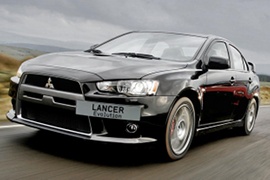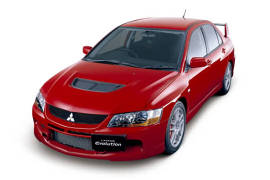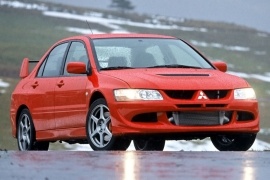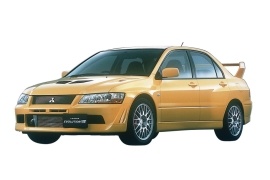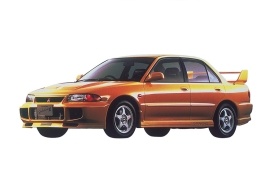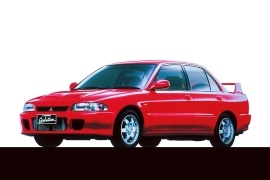MITSUBISHI Lancer Evolution Models/Series Timeline, Specifications & Photos
First production year: 1992
Engines: Gasoline
Mitsubishi threw another sequel after its famous Lancer Evolutions models on the market in 2008, and the upgrades compared with its predecessors were massive.
When the Japanese automaker made the rally-spec version of the Lancer in 1992, the car became an instant success thanks to its performance. It was nimble, powerful, light, and affordable to many. Furthermore, Mitsubishi worked on the Lancer Evolution and constantly upgraded it almost every year. These cars won many rallies worldwide and got the World Rally Championship under its belt. Still, the market changed, and customers started to look for more comfort and enhanced features on their sports cars. As a result, in 2007, the production version of the Lancer came on the Japanese market.
While it was related to the Evo IX, the tenth version of this nameplate was massively changed. At the front, the car sported a tall trapezoidal-shaped grille horizontally crossed by a beam. Its angular headlights tried to resemble a pair of angry eyes, while the lower bumper sported a set of fog lamps on its outer sides. Like all other Lancer Evolution before, the automaker added functional extracting vents on the hood. These vents were designed to help with heat extraction from the engine bay, contributing to better engine cooling during high-performance driving situations.
From its profile, the car looked like it leaned forward due to its ascending beltline and the narrow nose. In addition, behind the front wheels, Mitsubishi added extracting vents that released the air trapped in the front wheel wells and reduced the aerodynamic lift. A set of side sills made the car look lower to the ground, while at the back, the automaker added a wing on the short deck. From behind, the LED taillights were extended from the quarter panels to the trunk lid, and their shape echoed the headlights’ design. Finally, under the bumper, the carmaker added two oval exhausts integrated into the rear diffuser.
Mitsubishi sold the Lancer Evolution X in a few trim levels, depending on the market and model year. The base version featured mundane seats and only a few options. Meanwhile, the top-spec version featured Recaro sports seats at the front with tall seatbacks and integrated headrests. Their high bolstered areas kept their occupants in place during high-speed cornering maneuvers. The driver fronted a dashboard with large dials for the speedometer and the tachometer that flanked a small LCD that showed data from the car’s onboard computer. Atop the center stack, between the center vents, Mitsubishi installed a touchscreen for the infotainment system that featured navigation and a Rockford Fosgate sound system as an option. The bench in the back was flat and didn’t provide too much legroom for passengers, although it was good enough for short jaunts.
But most customers bought the Evo for what was under the car’s skin: the engine and transmission. All vehicles came fitted with the brand-new all-aluminum 4B11T4 Turbo MIVEC engine that replaced the formerly used open-deck 4G63 powerplant that powered the previous generations of the Lancer. The automaker paired the new unit with either a five-speed manual gearbox or with a six-speed automatic (dual-clutch) transmission that sent the power in all corners via one of the most advanced all-wheel drive systems on the market named S-AWD (Super All Wheel Control).
The Mitsubishi Lancer Evolution IX was an enhanced version of its predecessor, the Evolution VIII. It came with features that were fitted for a rally car, but able to be driven on the street.
The ninth evolution model of the Lancer was unveiled in Japan and at the Geneva Motor Show in 2005 on the same day. One month later, in April, it was shown at the New York International Auto Show. It featured almost the same specifications as the Evo VIII, but with some improvements over the engine and for the special MR edition.
The exterior of the car featured wide open in the front spoiler and the big intercooler for the turbo was exposed. On its sides, there were two fog-lights and another pair of cooling vents for the brakes. The black mesh-grille supported only the three-diamond chromed Mitsubishi logo. On the hood, there was an air-extraction vent that was not only for show. It was functional. On the rear side of the roof, Mitsubishi installed a line of small, shark-like, fins, which helped the aerodynamic. The rear massive spoiler on the trunk was fitted with an adjustment system, to help increase the downforce on the rear axle. While the MR featured special BBS light-alloy wheels, the rest of the lineup was fitted with a set of ENKEI wheels.
Inside, the Lancer featured sport-bucket seats and, for the MR edition, Recaro seats and Momo steering wheel. The instrument cluster featured four dials and a traction system indicator for the three settings available: tarmac, gravel, and snow.
Under the hood, there was the same 4G63 engine fitted on many Lance Evolution models, but for the IXth version, it was fitted with a variable valve timing named MIVEC. Apart from the MR version, which was fitted with a 6-speed manual, the rest of the trim levels had only 5-speed gearboxes. All models were all-wheel-drive.
Introduced at the Tokyo Motor Show in 2003, the Lancer Evo VIII continued the series of rally-bred Japanese vehicles produced by Mitsubishi.
While it didn't look like a completely new model, such as its predecessor compared to the Evo VI, the eighth generation of the Lancer Evo came with some improvements on its drivetrain. Even though its 4G63 engine was still declared with the same amount of power, 280 PS (276 hp), it was faster. One of the reasons was the new six-speed manual that was offered on specific versions. And yet, the base model featured a five-speed manual, and it was the base version for true rally cars.
With a front fascia that featured wide headlights and a narrow, split-in-two grille, the Evo 8 was a factory sleeper. There were just a few hints that could reveal the car's performance. Thus, the new 17" alloy wheels, the wing on the trunk, and the red Brembo calipers confirmed the sedan's ambitions. Nevertheless, the vents on the hood were anything but subtle.
Inside, depending on the trim level, the Evo VIII was either fitted with a bland interior or one that boasted sport seats, a high-quality sound system with a factory-mounted subwoofer in the trunk, air-conditioning, and power windows. Still, the instrument cluster looked the same, with the tachometer that took the center stage flanked by the speedometer on the left and three gauges on the right.
But the most significant upgrade was under its skin. Those who paid more for these cars had received the improved gearbox and active differentials, both front and rear, that mildly reduced understeer.
This generation of the Lancer Evolution was the most significant one since the Evo IV and offered essential technical upgrades on the all-wheel drive system.
Mitsubishi had high hopes for the Evo VII. It put a lot of effort and engineering upgrades into creating a stunning vehicle. Like its predecessors, it starred in the World Rally Championship. Unfortunately for the Japanese automaker, its hopes were shattered by the new competitors. It was too long to win races, but on the streets, it was a successful, desired model.
Starting with this generation, the Japanese automaker was able to offer the car with the same nameplate around the world, including in Europe, where it was previously forced to use the Carisma name due to copyright infringements. The Evo VII featured wider, clear lens headlights that covered the individual lamps for the high and low beam and the corner-mounted blinker. By now, the Lancer Evo was already famous for its vent on the hood, and Mitsubishi kept it, although it was not a vent but an air intake.
Mitsubishi offered the Lancer Evolution VII in two trim levels: RS and GSR. The former was used as a base version for rally teams to develop their race cars. It featured steel wheels, no power windows, no radio nor AC, and some of the cheapest, ready-to-trash seats in the industry. The GSR, on the other hand, was fully loaded with AC, a powerful sound system, sport bucket seats, and all the amenities of a 2000's sedan fit for families.
The technical part was the most intriguing since it featured a newly developed all-wheel drive system fitted with an active center differential, with three different settings for tarmac, snow, and gravel.
The sixth generation of the Lancer Evolution was more of a leap than a step ahead of its predecessor. A new drivetrain made a big difference.
The World Rally Championship was at its heights in the late '90s. Seven official factory teams gathered points for the final chart. Mitsubishi introduced the new car and it ended in fourth place. But it was six times on the podium and had a victory in the inaugural race, at Monte Carlo. The new Lancer Evolution WRC was based on the EVO VI model. It was rough, hard to control, and with new technologies that were difficult to understand by the drivers.
From the outside, the outrageous looking hood with extracting air-vents, the huge and flat apron for the intercooler, and the straight-cut headlights give the others a clue about what lies under the car. The big adjustable wing in the back was fully functional, adding aerodynamic load at high speeds.
Inside, the base model was basic. The cheapest seats, no AC, no radio, no power windows, and available only with steel wheels and white. It was built for private rally teams from around the world. The top trim levels offered Recaro sport-bucket seats and all the comfort for a quick car. The special TME (Tommi Makinen Editon) featured a special painting scheme, that mimicked the rally car.
The Lancer Evo VI was fitted with a 2.0-liter engine that offered, officially, 280 hp. It was mated to a 5-speed manual. The all-wheel-drive system featured a limited-slip differential in the back and an intelligent center differential. That was the biggest difference when compared to the Evo V. And, of course, nobody believed that a 280 hp sedan could get a 0-100 kph (0-62 mph) in 4.4 seconds.
The fifth sequel of the Lancer Evolution happened in 1998 when the Japanese carmaker made a crucial upgrade for this rally-ready road car.
In the late 90s, Mitsubishi had to adapt to new FIA regulations regarding rally cars. But the automaker had already prepared a successor for the Lancer, so the Evo V came not only with some engineering upgrades but with a different, wilder look. Moreover, since the Evo V was a serial production model, built on assembly lines, and shared many parts with the regular Lancer, Mitsubishi could sell it for less than other supercars of that era.
The redesigned Lancer Evo V featured larger headlights than its predecessor. Moreover, the carmaker penned the car with rally specs in mind. Thus, the front bumper received bigger than usual fog lamps. They flanked the broad lower grille that adorned the apron and let bystanders see the big radiators behind it. To further emphasize the car's rally origins, the hood sported two vents that helped cool the engine bay. From its sides, the wedged-shaped car sported flared wheel arches, aerodynamic side sills, and a big wing on the trunk. That was not for decoration, but it actually pushed the back of the car harder onto the road.
Inside, it was a civilized vehicle with an AC, a sound system, and an instrument cluster that showed more than 150 mph on the clock. That and the sports seats were other clues regarding the car's performance. But it could still be used as a daily driver, as long as the driver didn't complain about the manual-gearbox-only option and the neck-hurting accelerations. Moreover, the rear passengers seated on the bench had to hold tight to stay in place during high-speed cornering.
Under the hood, Mitsubishi still used the 4G63 powerplant, albeit it produced 276 HP (280 PS). Power went in all corners via an innovative all-wheel drive system created by Mitsubishi for this vehicle.
The Lancer Evolution IV was a true milestone in the rally-race inspired cars from Mitsubishi. It was launched in 1996 and it was the first to introduce the Active Yaw Control, which made the car faster on the bends.
The Lancer Evo IV was launched in two versions: the RS and the GSR. The RS was the base model to be transformed as a rally car. It was white, with the cheapest seats in the house and bare steel wheels. It was just easy to buy and to transform. It featured all the important technology included. The GSR version was the road-going model, with more comfort options, alloy wheels, and a better interior.
The Lancer Evo IV had a fierce look on the road, to match its performances. It featured big fog lights, a sculptured hood, and big air intakes in the front bumper. A massive wing was installed in the back. Also, there was a specific design for the taillights, which became a signature for the future Evo models.
Inside, the GSR featured race-bucket seats and better equipment, such as air-conditioning or power windows. For some countries, it was available with a sunroof.
The technology underneath the skin was impressive. The 2.0-liter turbocharged gasoline engine, named 4G63, featured a larger intercooler than its predecessor and offered more power. The all-wheel-drive system was equipped with an active center differential, named Active Yaw Control that could distribute the torque between the front and rear wheels. A limited-slip rear differential was available on the options list. A 5-speed manual was the only transmission offered.
Mitsubishi was on the verge of improving its Lancer Evolution, which aimed high in the World Rally Championship, and in February 1995, it unveiled the third iteration of this nameplate.
While Subaru and other automakers didn't make new versions each year for the cars used as rally-contenders, Mitsubishi worked tirelessly to get there. Thus, in less than three years, it jumped from the Evo to Evo III. Even though all of them were based on the same platform carried over from the Lancer's fifth generation, there were new improvements.
The most significant visual upgrade for the Evo III was the hood. Unlike its predecessor, it featured two broad air intakes on it that fed the engine with cold air from the outside. In addition, the front bumper was redesigned to accommodate a larger air intake for the intercooler and a lower lip spoiler to minimize the ground effect. At the back, the automaker installed an adjustable rear wing on the trunk.
The Evo III's cabin was similar to the one fitted in the Evo II. Just like its predecessor, it used the cheapest seats on the market for the base trim level and high-bolstered ones for the upper variants. Still, the curved dashboard design and the instrument panel could've been improved. On the GSR trim level, the Recaro sport seats were fitted as standard.
Featuring the same 4G63 engine as the rest of the Lancer Evolution range, the 1995 Evo III variant provided 270 PS (266 hp), which was enough to propel the vehicle at a fast pace, thanks to its five-speed manual that sent the power in all corners.
The Mirage-based Evolution II showed some improvements over the first Evo and revealed Mitsubishi's plans to create a true contender for the World Rally Championship.
After the ban on the Group B rally cars, the motorsport arena was left with the Group A and Group N vehicles. These had to share engines, drivetrains, and bodywork with a production vehicle built in high numbers.
The second generation of the Evolution (Evo, for short) was designed around the technical platform. That led to a new front styling that sported a new hood with extracting vents and a broad lower grille in the apron where the intercooler was placed. Moreover, a pair of scoops allowed cooling for the front brakes. With its four-door sedan shape, the Evo II was noticeable mostly due to its unique white five-spoke wheels and the wing on the trunk. Moreover, this car could have been fitted with a rear wiper, even though it was a three-box sedan!
Inside, there was the same bland-looking interior enhanced only by the sports seats for the front occupants. The dashboard was simple, featuring a waved-shaped instrument cluster in front of the driver. The center stack gathered all the buttons for the HVAC and the stereo. These two were fitted as standard on the GSR version, while the base model was stripped from all amenities and used only to be transformed into rally cars. But, it could still take five people inside, although the one sitting in the middle had to deal with the transmission tunnel.
Under the hood was the famous 4G63 two-liter powerplant that was placed up to the latter Evo versions and also powered the Mitsubishi Eclipse and the Eagle Talon TSI AWD. The five-speed manual transmission sent the power in all corners, and the rear axle featured a mechanical LSD fitted as standard.
Mitsubishi was very active in the rallying world with the Gallant VR4, but that awesome car had a huge disadvantage: it was too big, so it came down to this: the first Lancer RS.
When the Japanese introduced the Lancer RS, nobody called it an Evo, but after the second evolution came to replace it, people started to call this 1992 Lancer RS as the Evo I. Basically, it was renamed after it was withdrawn from the market.
While the car was based on a smaller platform, also used for the Colt, it was shorter than the Gallant VR4. Thus, it didn't need the all-wheel steering system from its bigger brother, and it could tackle the tracks just as well as its main opponents from Ford, Lancia, Subaru, or Toyota.
In the post-Group-B era, FIA (the world's motorsports federation) promoted a smaller class named Group-A. Vehicles from that racing category had to keep the basic features of a production model but with some specific set of modifications. Thus, the cars from that category had to keep their engine and transmission system. The Gallant VR4 also followed those rules, but it proved to be too big for narrow rally stages, so Mitsubishi transferred most of the technology from that car into the Lancer, resulting in the Lancer RS or its better-equipped sibling, the Lancer GSR.
RS came from Rally Special, and that's exactly what this car was. A base model for a rally car fitted with cheap seats ready to be thrown away, steel wheels, and no comfort amenities inside. The GSR, on the other hand, featured power windows and locks, air-conditioning, and a stereo.
Power came from the famous 4G63 two-liter turbocharged engine and was sent in all corners via a five-speed manual only.
